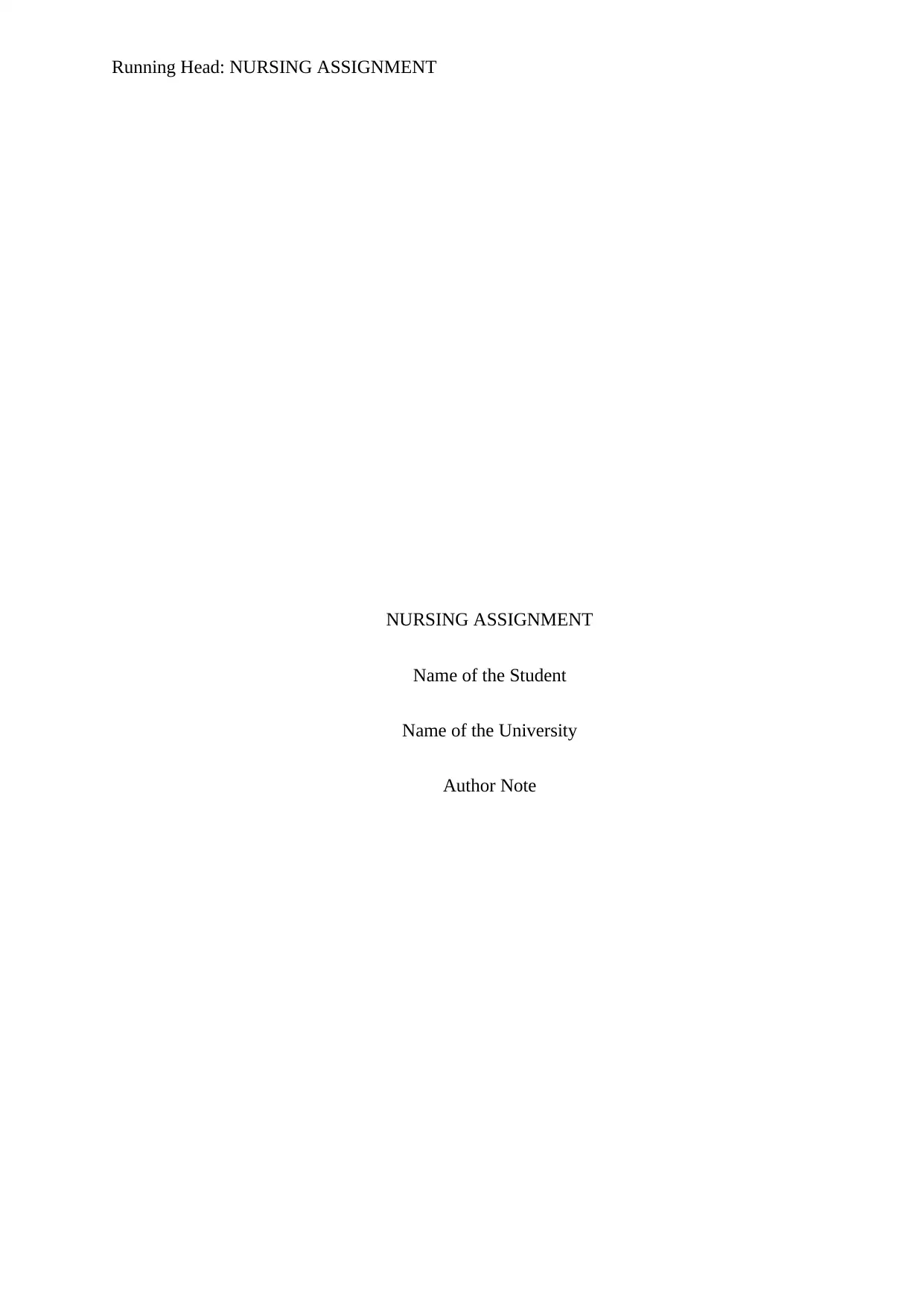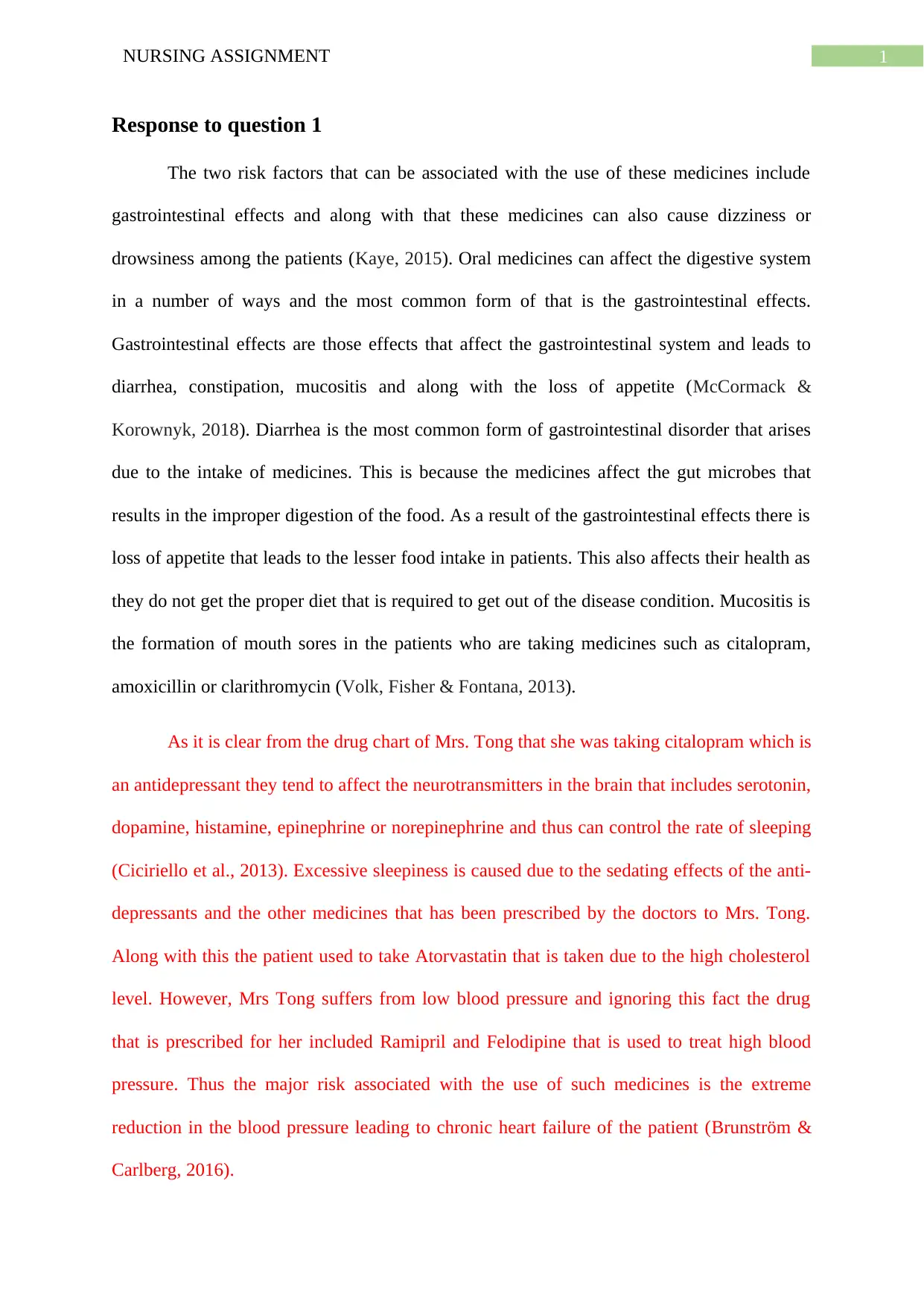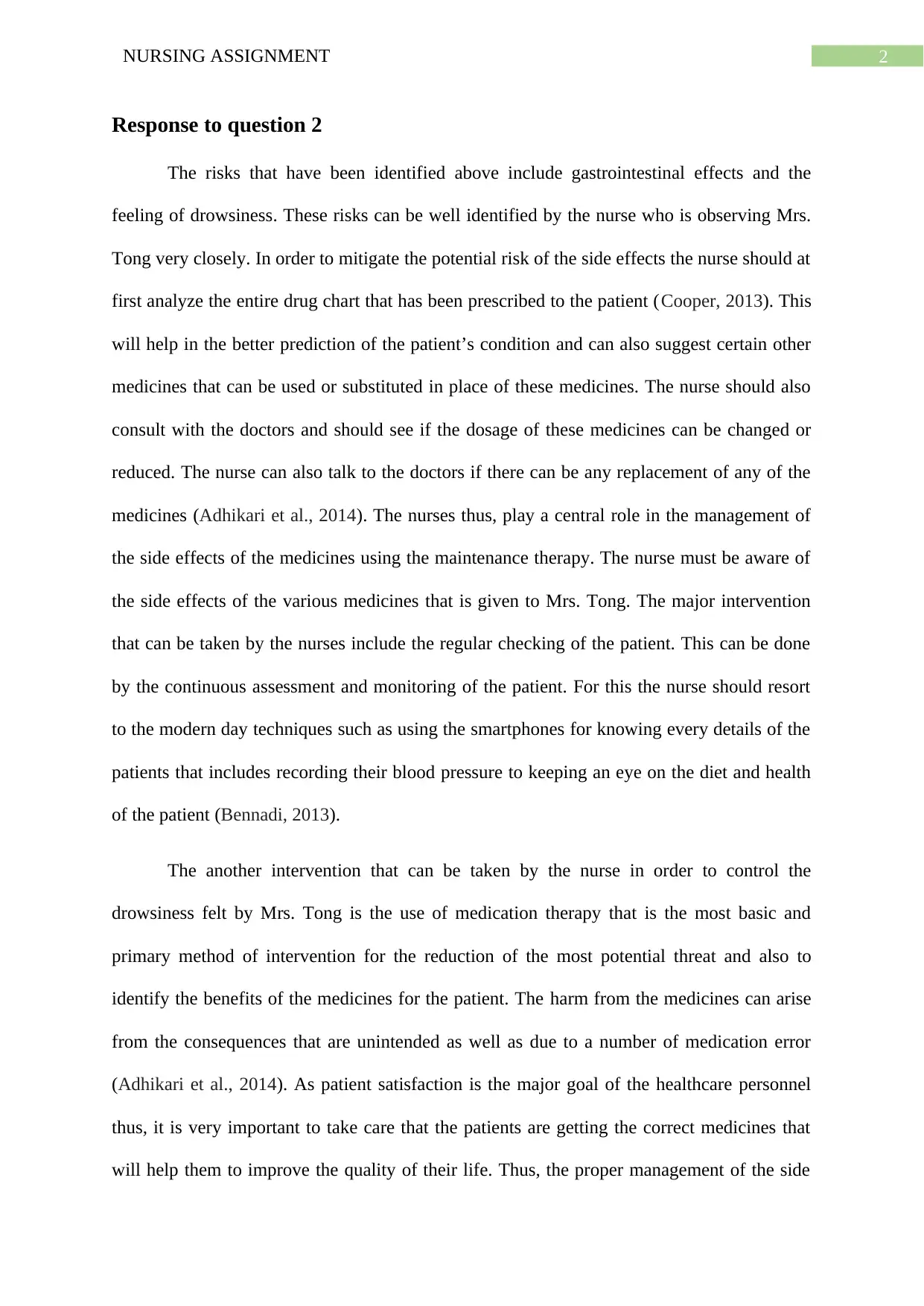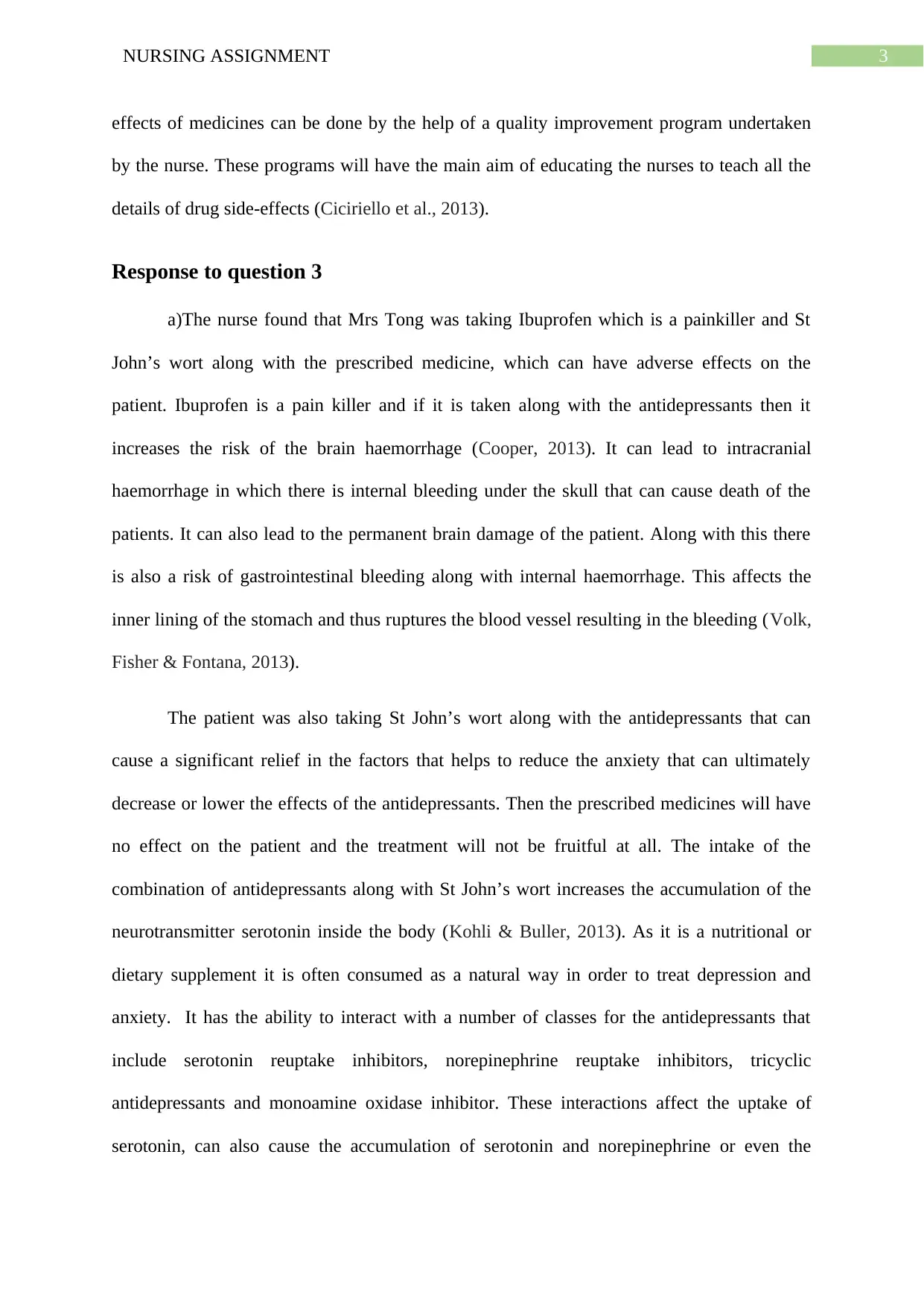HNN215 Nursing Assignment: Risks and Management of Medicines
VerifiedAdded on 2022/10/03
|8
|2167
|72
Report
AI Summary
This nursing assignment focuses on the case of Ms. Candice Tong, a 56-year-old patient admitted to the hospital with peptic ulcers, hypertension, hyperlipidemia, and depression. The assignment analyzes the risks associated with Ms. Tong's medications, including gastrointestinal effects, drowsiness, and potential drug interactions with over-the-counter drugs like Ibuprofen and St. John's wort. It explores nursing interventions to mitigate these risks, such as assessing the patient's drug chart, consulting with doctors, monitoring for side effects, and educating the patient about the safe use of medications. The assignment also highlights the importance of patient education regarding the combined use of prescribed and over-the-counter drugs, emphasizing the need for informed decision-making, awareness of potential side effects, and adherence to prescribed dosages to ensure patient safety and improve the quality of life. The assignment concludes with recommendations for nursing practice and patient education strategies to promote the quality use of medicines.

Running Head: NURSING ASSIGNMENT
NURSING ASSIGNMENT
Name of the Student
Name of the University
Author Note
NURSING ASSIGNMENT
Name of the Student
Name of the University
Author Note
Paraphrase This Document
Need a fresh take? Get an instant paraphrase of this document with our AI Paraphraser

1NURSING ASSIGNMENT
Response to question 1
The two risk factors that can be associated with the use of these medicines include
gastrointestinal effects and along with that these medicines can also cause dizziness or
drowsiness among the patients (Kaye, 2015). Oral medicines can affect the digestive system
in a number of ways and the most common form of that is the gastrointestinal effects.
Gastrointestinal effects are those effects that affect the gastrointestinal system and leads to
diarrhea, constipation, mucositis and along with the loss of appetite (McCormack &
Korownyk, 2018). Diarrhea is the most common form of gastrointestinal disorder that arises
due to the intake of medicines. This is because the medicines affect the gut microbes that
results in the improper digestion of the food. As a result of the gastrointestinal effects there is
loss of appetite that leads to the lesser food intake in patients. This also affects their health as
they do not get the proper diet that is required to get out of the disease condition. Mucositis is
the formation of mouth sores in the patients who are taking medicines such as citalopram,
amoxicillin or clarithromycin (Volk, Fisher & Fontana, 2013).
As it is clear from the drug chart of Mrs. Tong that she was taking citalopram which is
an antidepressant they tend to affect the neurotransmitters in the brain that includes serotonin,
dopamine, histamine, epinephrine or norepinephrine and thus can control the rate of sleeping
(Ciciriello et al., 2013). Excessive sleepiness is caused due to the sedating effects of the anti-
depressants and the other medicines that has been prescribed by the doctors to Mrs. Tong.
Along with this the patient used to take Atorvastatin that is taken due to the high cholesterol
level. However, Mrs Tong suffers from low blood pressure and ignoring this fact the drug
that is prescribed for her included Ramipril and Felodipine that is used to treat high blood
pressure. Thus the major risk associated with the use of such medicines is the extreme
reduction in the blood pressure leading to chronic heart failure of the patient (Brunström &
Carlberg, 2016).
Response to question 1
The two risk factors that can be associated with the use of these medicines include
gastrointestinal effects and along with that these medicines can also cause dizziness or
drowsiness among the patients (Kaye, 2015). Oral medicines can affect the digestive system
in a number of ways and the most common form of that is the gastrointestinal effects.
Gastrointestinal effects are those effects that affect the gastrointestinal system and leads to
diarrhea, constipation, mucositis and along with the loss of appetite (McCormack &
Korownyk, 2018). Diarrhea is the most common form of gastrointestinal disorder that arises
due to the intake of medicines. This is because the medicines affect the gut microbes that
results in the improper digestion of the food. As a result of the gastrointestinal effects there is
loss of appetite that leads to the lesser food intake in patients. This also affects their health as
they do not get the proper diet that is required to get out of the disease condition. Mucositis is
the formation of mouth sores in the patients who are taking medicines such as citalopram,
amoxicillin or clarithromycin (Volk, Fisher & Fontana, 2013).
As it is clear from the drug chart of Mrs. Tong that she was taking citalopram which is
an antidepressant they tend to affect the neurotransmitters in the brain that includes serotonin,
dopamine, histamine, epinephrine or norepinephrine and thus can control the rate of sleeping
(Ciciriello et al., 2013). Excessive sleepiness is caused due to the sedating effects of the anti-
depressants and the other medicines that has been prescribed by the doctors to Mrs. Tong.
Along with this the patient used to take Atorvastatin that is taken due to the high cholesterol
level. However, Mrs Tong suffers from low blood pressure and ignoring this fact the drug
that is prescribed for her included Ramipril and Felodipine that is used to treat high blood
pressure. Thus the major risk associated with the use of such medicines is the extreme
reduction in the blood pressure leading to chronic heart failure of the patient (Brunström &
Carlberg, 2016).

2NURSING ASSIGNMENT
Response to question 2
The risks that have been identified above include gastrointestinal effects and the
feeling of drowsiness. These risks can be well identified by the nurse who is observing Mrs.
Tong very closely. In order to mitigate the potential risk of the side effects the nurse should at
first analyze the entire drug chart that has been prescribed to the patient (Cooper, 2013). This
will help in the better prediction of the patient’s condition and can also suggest certain other
medicines that can be used or substituted in place of these medicines. The nurse should also
consult with the doctors and should see if the dosage of these medicines can be changed or
reduced. The nurse can also talk to the doctors if there can be any replacement of any of the
medicines (Adhikari et al., 2014). The nurses thus, play a central role in the management of
the side effects of the medicines using the maintenance therapy. The nurse must be aware of
the side effects of the various medicines that is given to Mrs. Tong. The major intervention
that can be taken by the nurses include the regular checking of the patient. This can be done
by the continuous assessment and monitoring of the patient. For this the nurse should resort
to the modern day techniques such as using the smartphones for knowing every details of the
patients that includes recording their blood pressure to keeping an eye on the diet and health
of the patient (Bennadi, 2013).
The another intervention that can be taken by the nurse in order to control the
drowsiness felt by Mrs. Tong is the use of medication therapy that is the most basic and
primary method of intervention for the reduction of the most potential threat and also to
identify the benefits of the medicines for the patient. The harm from the medicines can arise
from the consequences that are unintended as well as due to a number of medication error
(Adhikari et al., 2014). As patient satisfaction is the major goal of the healthcare personnel
thus, it is very important to take care that the patients are getting the correct medicines that
will help them to improve the quality of their life. Thus, the proper management of the side
Response to question 2
The risks that have been identified above include gastrointestinal effects and the
feeling of drowsiness. These risks can be well identified by the nurse who is observing Mrs.
Tong very closely. In order to mitigate the potential risk of the side effects the nurse should at
first analyze the entire drug chart that has been prescribed to the patient (Cooper, 2013). This
will help in the better prediction of the patient’s condition and can also suggest certain other
medicines that can be used or substituted in place of these medicines. The nurse should also
consult with the doctors and should see if the dosage of these medicines can be changed or
reduced. The nurse can also talk to the doctors if there can be any replacement of any of the
medicines (Adhikari et al., 2014). The nurses thus, play a central role in the management of
the side effects of the medicines using the maintenance therapy. The nurse must be aware of
the side effects of the various medicines that is given to Mrs. Tong. The major intervention
that can be taken by the nurses include the regular checking of the patient. This can be done
by the continuous assessment and monitoring of the patient. For this the nurse should resort
to the modern day techniques such as using the smartphones for knowing every details of the
patients that includes recording their blood pressure to keeping an eye on the diet and health
of the patient (Bennadi, 2013).
The another intervention that can be taken by the nurse in order to control the
drowsiness felt by Mrs. Tong is the use of medication therapy that is the most basic and
primary method of intervention for the reduction of the most potential threat and also to
identify the benefits of the medicines for the patient. The harm from the medicines can arise
from the consequences that are unintended as well as due to a number of medication error
(Adhikari et al., 2014). As patient satisfaction is the major goal of the healthcare personnel
thus, it is very important to take care that the patients are getting the correct medicines that
will help them to improve the quality of their life. Thus, the proper management of the side
⊘ This is a preview!⊘
Do you want full access?
Subscribe today to unlock all pages.

Trusted by 1+ million students worldwide

3NURSING ASSIGNMENT
effects of medicines can be done by the help of a quality improvement program undertaken
by the nurse. These programs will have the main aim of educating the nurses to teach all the
details of drug side-effects (Ciciriello et al., 2013).
Response to question 3
a)The nurse found that Mrs Tong was taking Ibuprofen which is a painkiller and St
John’s wort along with the prescribed medicine, which can have adverse effects on the
patient. Ibuprofen is a pain killer and if it is taken along with the antidepressants then it
increases the risk of the brain haemorrhage (Cooper, 2013). It can lead to intracranial
haemorrhage in which there is internal bleeding under the skull that can cause death of the
patients. It can also lead to the permanent brain damage of the patient. Along with this there
is also a risk of gastrointestinal bleeding along with internal haemorrhage. This affects the
inner lining of the stomach and thus ruptures the blood vessel resulting in the bleeding (Volk,
Fisher & Fontana, 2013).
The patient was also taking St John’s wort along with the antidepressants that can
cause a significant relief in the factors that helps to reduce the anxiety that can ultimately
decrease or lower the effects of the antidepressants. Then the prescribed medicines will have
no effect on the patient and the treatment will not be fruitful at all. The intake of the
combination of antidepressants along with St John’s wort increases the accumulation of the
neurotransmitter serotonin inside the body (Kohli & Buller, 2013). As it is a nutritional or
dietary supplement it is often consumed as a natural way in order to treat depression and
anxiety. It has the ability to interact with a number of classes for the antidepressants that
include serotonin reuptake inhibitors, norepinephrine reuptake inhibitors, tricyclic
antidepressants and monoamine oxidase inhibitor. These interactions affect the uptake of
serotonin, can also cause the accumulation of serotonin and norepinephrine or even the
effects of medicines can be done by the help of a quality improvement program undertaken
by the nurse. These programs will have the main aim of educating the nurses to teach all the
details of drug side-effects (Ciciriello et al., 2013).
Response to question 3
a)The nurse found that Mrs Tong was taking Ibuprofen which is a painkiller and St
John’s wort along with the prescribed medicine, which can have adverse effects on the
patient. Ibuprofen is a pain killer and if it is taken along with the antidepressants then it
increases the risk of the brain haemorrhage (Cooper, 2013). It can lead to intracranial
haemorrhage in which there is internal bleeding under the skull that can cause death of the
patients. It can also lead to the permanent brain damage of the patient. Along with this there
is also a risk of gastrointestinal bleeding along with internal haemorrhage. This affects the
inner lining of the stomach and thus ruptures the blood vessel resulting in the bleeding (Volk,
Fisher & Fontana, 2013).
The patient was also taking St John’s wort along with the antidepressants that can
cause a significant relief in the factors that helps to reduce the anxiety that can ultimately
decrease or lower the effects of the antidepressants. Then the prescribed medicines will have
no effect on the patient and the treatment will not be fruitful at all. The intake of the
combination of antidepressants along with St John’s wort increases the accumulation of the
neurotransmitter serotonin inside the body (Kohli & Buller, 2013). As it is a nutritional or
dietary supplement it is often consumed as a natural way in order to treat depression and
anxiety. It has the ability to interact with a number of classes for the antidepressants that
include serotonin reuptake inhibitors, norepinephrine reuptake inhibitors, tricyclic
antidepressants and monoamine oxidase inhibitor. These interactions affect the uptake of
serotonin, can also cause the accumulation of serotonin and norepinephrine or even the
Paraphrase This Document
Need a fresh take? Get an instant paraphrase of this document with our AI Paraphraser

4NURSING ASSIGNMENT
dopamine levels inside the brain. The accumulation of these neurotransmitters can affect the
mechanism of action of antidepressants ultimately affecting the entire treatment process of
the patient (Bennadi, 2013).
b)The three key points that has to explained by the nurse to Mrs Tong will giving her
education regarding the lesser use of the over the counter medicines. The buying of the over
the counter drugs do not need a prescription of the doctor and is thus can be easily purchased
by the individuals without the prior consultation of the doctor (McCormack & Korownyk,
2018). The first key point that has to be taught by the nurse to the patient includes the
teaching of the side effects of the combined use of the prescribed medicines along with the
over the counter drugs. The nurse can teach Mrs Tong that the combined use of the drugs can
reduce the actual efficacy of the prescribed medicine. This will affect the treatment process of
the patient and there will be a decrease in the quality of life for the patient (Kaye, 2015).
The key point that can be taught to the patient while educating her regarding the lesser
use of over the counter drugs is that these drugs should be used in a complete informed
process, and that the nurse should encourage her to know the entire information regarding the
safe dosage and also the side effects of each of the medicines (Whiskey & Taylor, 2013). The
nurse should also emphasize that the patient should take a note of the effective usage of the
drugs. The nurse should educate Mrs Tong that these factors are necessary to consider before
her discharge as the symptoms related to the misuse or over use of the over the counter drugs
might not be detected until there is proper information about these drugs (Gordon & Melvin,
2013).
Another point that has to be considered by the nurse in order to educate the patient
over the use of the over the counter drugs include the buying of the drugs should be done by
reading the label of the medicine and thus by deciding or asking the pharmacist that whether
dopamine levels inside the brain. The accumulation of these neurotransmitters can affect the
mechanism of action of antidepressants ultimately affecting the entire treatment process of
the patient (Bennadi, 2013).
b)The three key points that has to explained by the nurse to Mrs Tong will giving her
education regarding the lesser use of the over the counter medicines. The buying of the over
the counter drugs do not need a prescription of the doctor and is thus can be easily purchased
by the individuals without the prior consultation of the doctor (McCormack & Korownyk,
2018). The first key point that has to be taught by the nurse to the patient includes the
teaching of the side effects of the combined use of the prescribed medicines along with the
over the counter drugs. The nurse can teach Mrs Tong that the combined use of the drugs can
reduce the actual efficacy of the prescribed medicine. This will affect the treatment process of
the patient and there will be a decrease in the quality of life for the patient (Kaye, 2015).
The key point that can be taught to the patient while educating her regarding the lesser
use of over the counter drugs is that these drugs should be used in a complete informed
process, and that the nurse should encourage her to know the entire information regarding the
safe dosage and also the side effects of each of the medicines (Whiskey & Taylor, 2013). The
nurse should also emphasize that the patient should take a note of the effective usage of the
drugs. The nurse should educate Mrs Tong that these factors are necessary to consider before
her discharge as the symptoms related to the misuse or over use of the over the counter drugs
might not be detected until there is proper information about these drugs (Gordon & Melvin,
2013).
Another point that has to be considered by the nurse in order to educate the patient
over the use of the over the counter drugs include the buying of the drugs should be done by
reading the label of the medicine and thus by deciding or asking the pharmacist that whether

5NURSING ASSIGNMENT
these pills will treat the symptoms that are observed by the patient or not. This will encourage
the patient to the lesser use of the drugs by the patient and thus reducing the overall side
effects related to the misuse of the drugs or the use of the drugs along with the prescribed
medicine (Wichniak et al., 2013). The patient should also be educated about the fact that the
number or amount of the over the counter drugs should be taken in a limited amount or as
written in the label so that there is no overdose and can also lessen the harmful effects ( Bet et
al., 2013).
these pills will treat the symptoms that are observed by the patient or not. This will encourage
the patient to the lesser use of the drugs by the patient and thus reducing the overall side
effects related to the misuse of the drugs or the use of the drugs along with the prescribed
medicine (Wichniak et al., 2013). The patient should also be educated about the fact that the
number or amount of the over the counter drugs should be taken in a limited amount or as
written in the label so that there is no overdose and can also lessen the harmful effects ( Bet et
al., 2013).
⊘ This is a preview!⊘
Do you want full access?
Subscribe today to unlock all pages.

Trusted by 1+ million students worldwide

6NURSING ASSIGNMENT
References
Adhikari, R., Tocher, J., Smith, P., Corcoran, J., & MacArthur, J. (2014). A multi-
disciplinary approach to medication safety and the implication for nursing education
and practice. Nurse education today, 34(2), 185-190.
Bennadi, D. (2013). Self-medication: A current challenge. Journal of basic and clinical
pharmacy, 5(1), 19.
Bet, P. M., Hugtenburg, J. G., Penninx, B. W., & Hoogendijk, W. J. (2013). Side effects of
antidepressants during long-term use in a naturalistic setting. European
neuropsychopharmacology, 23(11), 1443-1451.
Ciciriello, S., Johnston, R. V., Osborne, R. H., Wicks, I., deKroo, T., Clerehan, R., ... &
Buchbinder, R. (2013). Multimedia educational interventions for consumers about
prescribed and over‐the‐counter medications. Cochrane Database of Systematic
Reviews, (4).
Cooper, R. J. (2013). Over-the-counter medicine abuse–a review of the literature. Journal of
substance use, 18(2), 82-107.
Gordon, M., & Melvin, G. (2013). Selective serotonin re-uptake inhibitors: a review of the
side effects in adolescents. Australian family physician, 42(9), 620.
Kaye, A. D. (2015). Tramadol, pharmacology, side effects, and serotonin syndrome: a
review. Pain physician, 18, 395-400.
Kohli, E., & Buller, A. (2013). Factors influencing consumer purchasing patterns of generic
versus brand name over-the-counter drugs. South Med J, 106(2), 155-60.
McCormack, J., & Korownyk, C. (2018). Effectiveness of antidepressants.
References
Adhikari, R., Tocher, J., Smith, P., Corcoran, J., & MacArthur, J. (2014). A multi-
disciplinary approach to medication safety and the implication for nursing education
and practice. Nurse education today, 34(2), 185-190.
Bennadi, D. (2013). Self-medication: A current challenge. Journal of basic and clinical
pharmacy, 5(1), 19.
Bet, P. M., Hugtenburg, J. G., Penninx, B. W., & Hoogendijk, W. J. (2013). Side effects of
antidepressants during long-term use in a naturalistic setting. European
neuropsychopharmacology, 23(11), 1443-1451.
Ciciriello, S., Johnston, R. V., Osborne, R. H., Wicks, I., deKroo, T., Clerehan, R., ... &
Buchbinder, R. (2013). Multimedia educational interventions for consumers about
prescribed and over‐the‐counter medications. Cochrane Database of Systematic
Reviews, (4).
Cooper, R. J. (2013). Over-the-counter medicine abuse–a review of the literature. Journal of
substance use, 18(2), 82-107.
Gordon, M., & Melvin, G. (2013). Selective serotonin re-uptake inhibitors: a review of the
side effects in adolescents. Australian family physician, 42(9), 620.
Kaye, A. D. (2015). Tramadol, pharmacology, side effects, and serotonin syndrome: a
review. Pain physician, 18, 395-400.
Kohli, E., & Buller, A. (2013). Factors influencing consumer purchasing patterns of generic
versus brand name over-the-counter drugs. South Med J, 106(2), 155-60.
McCormack, J., & Korownyk, C. (2018). Effectiveness of antidepressants.
Paraphrase This Document
Need a fresh take? Get an instant paraphrase of this document with our AI Paraphraser

7NURSING ASSIGNMENT
Volk, M. L., Fisher, N., & Fontana, R. J. (2013). Patient knowledge about disease self-
management in cirrhosis. The American journal of gastroenterology, 108(3), 302.
Whiskey, E., & Taylor, D. (2013). A review of the adverse effects and safety of
noradrenergic antidepressants. Journal of Psychopharmacology, 27(8), 732-739.
Wichniak, A., Wierzbicka, A., Walęcka, M., & Jernajczyk, W. (2017). Effects of
antidepressants on sleep. Current psychiatry reports, 19(9), 63.
Brunström, M., & Carlberg, B. (2016). Effect of antihypertensive treatment at different blood
pressure levels in patients with diabetes mellitus: systematic review and meta-
analyses. Bmj, 352, i717.
Volk, M. L., Fisher, N., & Fontana, R. J. (2013). Patient knowledge about disease self-
management in cirrhosis. The American journal of gastroenterology, 108(3), 302.
Whiskey, E., & Taylor, D. (2013). A review of the adverse effects and safety of
noradrenergic antidepressants. Journal of Psychopharmacology, 27(8), 732-739.
Wichniak, A., Wierzbicka, A., Walęcka, M., & Jernajczyk, W. (2017). Effects of
antidepressants on sleep. Current psychiatry reports, 19(9), 63.
Brunström, M., & Carlberg, B. (2016). Effect of antihypertensive treatment at different blood
pressure levels in patients with diabetes mellitus: systematic review and meta-
analyses. Bmj, 352, i717.
1 out of 8
Related Documents
Your All-in-One AI-Powered Toolkit for Academic Success.
+13062052269
info@desklib.com
Available 24*7 on WhatsApp / Email
![[object Object]](/_next/static/media/star-bottom.7253800d.svg)
Unlock your academic potential
Copyright © 2020–2025 A2Z Services. All Rights Reserved. Developed and managed by ZUCOL.





